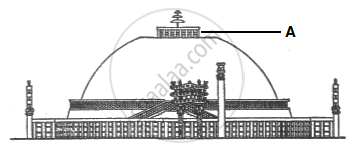Advertisements
Advertisements
प्रश्न
Write a short essay (about 500 words) on the following:
Discuss how and why stupas were built.
उत्तर
About 200 years after the time of Buddha King Asoka erected a pillar at Lumbini. This was to announce the visit of Buddha to this place.Stupas were the mounds put on the bodily remains of the body of Lord Buddha or of any object that was used by him. At the place of stupas such objects were buried. These were places of great respect under the tradition of Buddhism, as they had the relics of Buddha. As per the description of Asokavadana winch a famous Buddhist book, Emperor Asoka gave Buddha’s relic to all major cities. Later on such places stupas were put. The most important stupas are at Sanchi, Bharhut and Saranath.
The structure of a stupa was like a dome and hemisphere. On the top of it, there would be a balcony called harmik. This balcony represented the abode of God. The harmik was covered with an umbrella. There used to be railings around the balcony.
The construction of the stupas was made possible by the contribution of many. On the forefront were the monarchs. The Satvahan Kings offered huge amount for the construction of the stupqs. Apart from the monarchs, merchants, artisans and common men and women also contributed to the construction of the stupas.
APPEARS IN
संबंधित प्रश्न
Where did Buddha attain enlightenment?
According to which Buddhist text Asoka distributed portions of the Buddha’s relics to every important town and ordered the construction of stupas over them?
Who provided money for the preservation of the Sanchi Stupa?
What was the balcony-like structure in a stupa called?
Match the following.
| (i) | Lumbini | (a) | Buddha attained Nibbana |
| (ii) | Kusinagara | (b) | Buddha delivered his first sermon |
| (iii) | Sarnath | (c) | Buddha was born |
| (iv) | Bodh Gaya | (d) | Buddha attained enlightenment |
Choose the correct option
Consider the following statements regarding the structure of the stupa.
- Harmika is a balcony-like structure that represented the abode of gods.
- A mast called the and arose from the harmika.
- A yashti was often surmounted by a chhatri or umbrella.
- Yashti arose from the harmika.
Which of the following statements is/are correct?
The most splendid stupa was at ____________.
Which of the following is the oldest stupa in India and was commissioned by the Mauryan King Ashoka?
Read the following excerpt carefully and answer the question :
A Prayer to Agni
Here are two verses from the Rigveda invoking Agni, the God of Fire:
Bring, O strong one, this sacrifice of ours to the Gods, O wise one, as a liberal giver. Bestow on us, O priest, abundant food. Agni, obtain, by sacrificing, mighty wealth for us. Pro-cure, O Agni, forever to him who pays to you (the gift of) nourishment the wonderful cow. May a son be ours, offspring that continues our line...
Verses such as these were composed in a special kind of Sanskrit, known as Vedic Sanskrit. They were taught orally to men belonging to priestly families.
Vedic Sanskrit is considered to be important because ______
Buddha was born in ______.
Identify the term which defines the given below statement and give the correct answer.
"The stupa originated as a sample semi-circular mound of earth"
What was the balcony like structure in a stupa called?
Which of the following places are associated with the life of the Buddha?
(i) Lumbini
(ii) Kapilvastu
(iii) Bodh Gaya
(iv) Sarnath
The most important stupas existed at:
(i) Bharhut
(ii) Sanchi
(iii) Sarnath
Who told Ananda that the honour of his worldly remains was not important?
Look at the figure given below and identify the structural feature marked as 'X of the Sanchi stupa from the following options:

Which one of the following statement is correct?
Ashoka erected a pillar at ______ to mark that he had visited that place.
